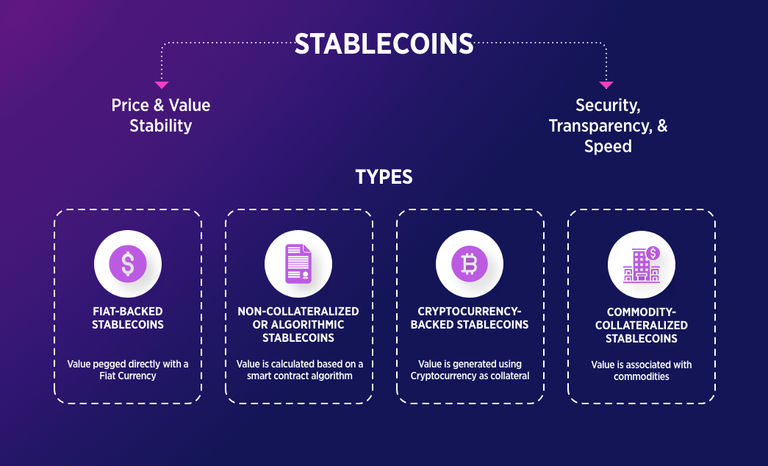Product backed Stable Coin
Stable Coin
For people who are in crypto for a while, they are familiar with stablecoins. Stablecoins are an important part of the crypto universe.
Stablecoins are a class of cryptocurrency that’s backed by “stable” reserve assets like gold and the U.S. dollar. Being pegged to reserve assets allows them to offer greater price stability than unpegged cryptocurrencies like Ethereum and Bitcoin.
I find it ironic, that all crypto coins and tokens are quoted in USD. We celebrate BTC is above $100K! We say death to the governments and federal reserve. Yet there is that $ sign. But I digress. Crypto universe had realized the need and potential of USD a long time ago, practically at the same time cryptocurrency got the name currency.

There have been a lot of stablecoins. Without getting into a lot of details, I made a simple table to summarize a few of them.
Types of Stablecoins
| Type | Description | Year Created | Creator(s)/Issuer(s) |
|---|---|---|---|
| Fiat-Backed Stablecoin | Pegged to a fiat currency (e.g., USD, EUR) with reserves held in banks or custodians. | 2014 | Tether Limited (USDT); Circle (USDC, 2018) |
| Commodity-Backed Stablecoin | Pegged to commodities like gold, silver, or oil, with physical assets held in reserve. | 2015 | Digix (DGX); Tether (XAUt, 2020); Paxos (PAXG, 2019) |
| Crypto-Backed Stablecoin | Backed by other cryptocurrencies (e.g., ETH) locked in smart contracts, often over-collateralized. | 2017 | MakerDAO (DAI) |
| Algorithmic Stablecoin | Maintains stability through algorithms and smart contracts that adjust supply based on demand, without direct asset backing. | 2017 | Basis (defunct); Ampleforth (2019); TerraUSD (2020, collapsed 2022) |
| Hybrid Stablecoin | Combines multiple backing mechanisms (e.g., fiat and crypto) for enhanced stability or flexibility. | 2018 | Havven (Synthetix, sUSD); Reserve (RSV, 2019) |
Out of all these, Fiat backed stablecoin like USDT or USDC, are perhaps most easy to understand. They hold the same amount of USD (or cash equivalent assets) in a reserve account as each token is minted. I know in case of circle (USDC), which is coinbase, a public company, these reserves and assets are publicly audited and transparent.
Similarly a gold backed stablecoin holds physical gold as assets in reserve.
Advantages and Risks of stablecoins
| Aspect | Advantages | Risks |
|---|---|---|
| Stability | - Less volatile than unbacked cryptocurrencies due to commodity pegging. - Tracks the relatively stable value of commodities like gold. | - Dependent on the commodity’s market price stability. - Risk of depegging if reserves are insufficient or mismanaged. |
| Accessibility | - Tokenizes commodities, making them easier to trade, divide, and transfer globally. - Accessible to anyone with internet, no bank account required. | - Centralized custody increases risks of hacks, fraud, or bankruptcy of the issuer. |
| Transparency | - Regular audits can ensure reserves match circulating supply. - Blockchain provides transparent transaction records. | - Lack of transparency if audits are irregular or falsified. |
| Use in DeFi | - Enables commodity-backed value in DeFi platforms for lending, trading, or payments. | - Limited liquidity in DeFi compared to fiat-backed stablecoins. |
| Regulation | - May face less regulatory scrutiny than fiat-backed stablecoins in some jurisdictions. | - Regulatory uncertainty in jurisdictions like the US and EU. |
DEC is a Product backed stablecoin
The reason I went into the background a little bit is because I like to investigate if DEC can really be a product backed stable coin. If it can, then how exactly, and what are the potential risks. Those of us who plays Splinterlands knows, DEC is used for transactions within the game, such as purchasing cards, potions, and other in-game assets, and is intended to function as a product-backed stablecoin soft-pegged to the US dollar at a rate of 1,000 DEC = $1.
This is where it gets murky.... the word soft-pegged.

Above is a hypothetical chart. The goal is to keep DEC as close to 1000 DEC = $1 price. We seek to maintain that through arbitrage opportunities and the flywheel mechanism. When DEC trades below the peg, players can buy it at a discount to use in the Splinterlands shop. When above the peg, burning SPS to mint DEC becomes more attractive.
So, if DEC falls below peg, the only mechanism to make people buy DEC, to get it near peg, is to have a product (read cards or packs or something similar) that is desirable for people to buy. This is loose and subjective. It is possible to do. For example, when we have new pack set sale, DEC stays near peg, because there is demand for it. But as pack sale die down, it tends to de-peg and slowly crawls downwards.
| Step | Description | Impact on Ecosystem |
|---|---|---|
| High DEC Demand | Players need DEC for in-game purchases (e.g., cards, packs, land staking, guild upgrades). Demand increases when DEC trades below the peg (1,000 DEC = $1), as players buy it at a discount for shop transactions. | Increases DEC’s market activity and liquidity, drawing more players to the game. |
| DEC Pegging | As demand rises, DEC’s market price approaches or exceeds the target peg (1,000 DEC = $1). This reduces the arbitrage opportunity for buying DEC at a discount. | Stabilizes DEC’s value, making it a reliable in-game currency and encouraging trust in the ecosystem. |
| SPS Burning for DEC | When DEC trades above the peg, players burn SPS tokens at a fixed rate ($1 worth of SPS = 975 DEC) to mint new DEC. This is more cost-effective than buying DEC at a premium on the market. | Reduces SPS supply, potentially increasing its value, and introduces new DEC to meet demand, maintaining the peg. |
| Flywheel Activation | Increased DEC usage fuels more in-game activity, attracting new players and boosting demand for DEC. This incentivizes more SPS burning, further reducing SPS supply and driving its value, which in turn supports DEC’s stability. | Creates a self-reinforcing cycle that enhances the ecosystem’s growth, player engagement, and token value. |
| Credit Purchases | Players can buy Credits (1,000 Credits = $1) with fiat or crypto. Splinterlands converts these Credits to DEC for transactions, sourcing DEC from company reserves or by burning SPS to mint DEC if reserves are low. | Adds external liquidity to the ecosystem, as company purchases of DEC or SPS burning increase market activity and support the peg. |
De-pegging Risk
Well let us walk through a hypothetical scenario.

- Days 1-3: DEC price hovers near the peg but starts declining as demand weakens (e.g., fewer players buying DEC for in-game purchases).
- Days 4-7: The price drops sharply below the lower bound, indicating depegging, possibly due to low SPS value making burning uneconomical or insufficient DEC sinks or both.
- Days 8-10: Minimal recovery suggests the flywheel (SPS burning) or arbitrage fails to restore the peg, reflecting a breakdown in stabilizing mechanisms.
How can we mitigate this risk?
It is not easy, and not always can be controlled. One of the main problem is DEC originally was not designed for this, a stablecoin. It was just a reward token in the beginning. So auditing DEC is hard. However, we must work towards an audit as soon as possible. Once we get the token supply/mint mechanism audited, then we can do the following items all the time.
- Increase DEC sinks (e.g., new in-game uses like guild upgrades or land staking or any desirable products).
- Enhance SPS burning incentives to boost DEC minting when prices rise.
If I can summarize with one sentence:
Always have something on the shelf that people desperately wants to buy!
If we can do that DEC can and will be a robust product backed stablecoin.


That an interesting topics you got here, you have dropped a clear insight on stable coins and DEC as well.
We are still waiting to see the future of DEC will it stand the test of time with SPS.
Many of us already have a good idea of the potential future of DEC.
I think DEC future is still in anticipation not a claim fate to say.
Great informative post...
i like how you describe the different type of stable coins then we come with DEC and that is a bit different, is closed to an Algorithmic Stablecoin i reckon?
But clear enough we need a constant demand on DEC and constant burning of DEC in parts of the game will also help.
The hypothetical scenario we have seen enough of in the past years, let see if it can hold this time now the tokenomics are in a better position.
I expect you remember what happened to Luna! Everyone's favorite algorithmic stable coin that was! Let's not go there! :)
Our concept is very sales oriented. We don't sale, we de-peg. It is that simple.
The only way we sale is if people want to buy something that is desirable to them. I don't want to be Captain Obvious here but obviously that is what I am doing! :)
I like the simplicity in it, make the experience fun and rewarding (not only monetary) and attract new/old players 😁
!PIZZA
Based on the past history of DEC it would make sense to start accumulating DEC when it is at least 30% under the Peg value and start selling it off when we have a new set of cards announced trying to sell in the 95%+ range. Expected return is not huge and might take some time, but if you have the capital that seems like a good way to go and would help smooth out the soft Peg fluctuations if a lot of capital would doing it and eventually the bounds of this trade would also fluctuate upwards under that scenario resulting in a more stable stablecoin.
Yes, this has happened many times, but I have failed to capitalize.
I don't think I would be able to talk about crypto if it wasn't specified in USD. I get the thinking behind it, but when people start talking about crypto in terms of SATS, it always confuses me. I think one day we might all start thinking that way, but USD dominance is just too high still.
World still runs on USD, that's just the reality
good read, thanks. 👍
Thank you. I was thinking about this a lot of the last few days.
The team has done a great job bringing DEC back close to peg. If I remember correctly it even dropped to 60 or 70% below peg.
Well a long time ago it was 30 cents on the dollar:)